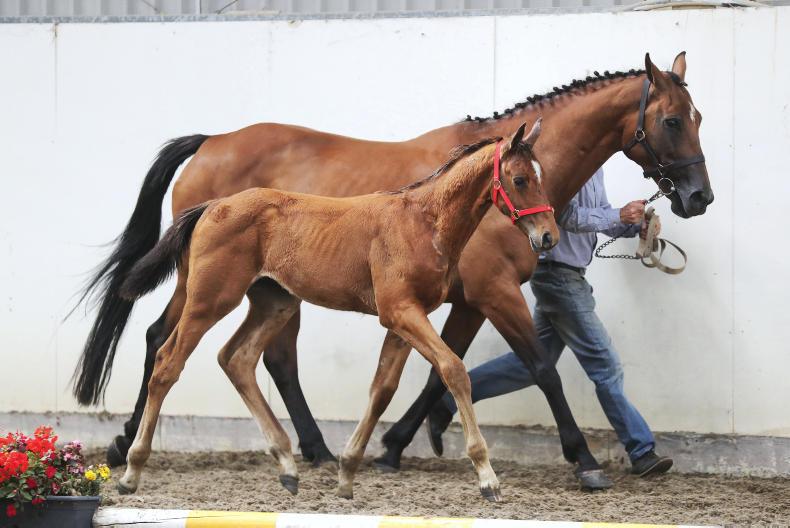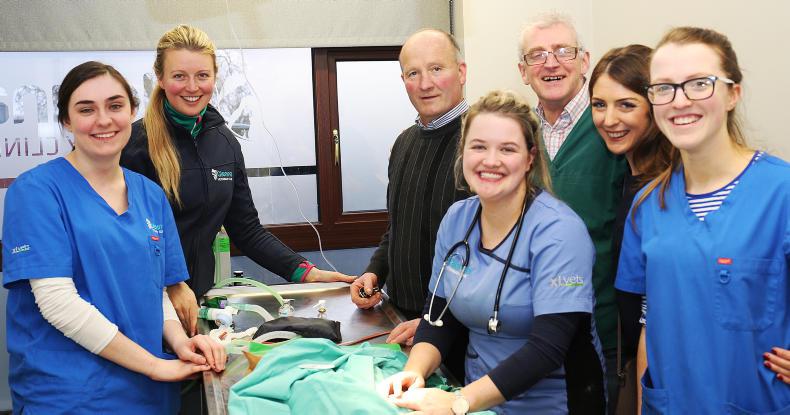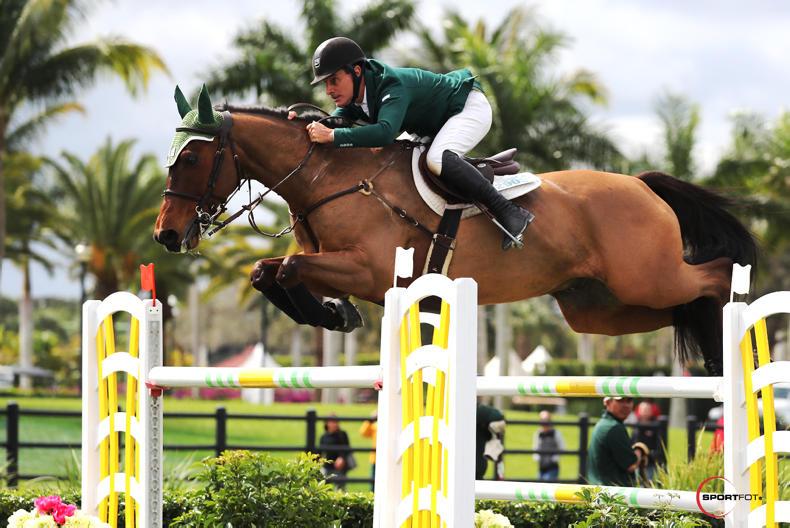Public auction results for foals and performance sales at Goresbridge (including Supreme Foal Sale Barnadown, Go For Gold Sale and Tattersalls Select Event Sale), Cavan, Mullingar (Mayo Roscommon Horse Breeders), and The Monart Sale were analysed. It is acknowledged that the majority of trade remains in the private domain and public auction trade can only provide limited insight into the overall trends.
Numbers sold
The number of foals sold in 2018 was on a par with 2014 and 2016, down 65 on those sold in 2017.
The number of three year olds presented, and sold, at public auction in 2018 were significantly down on preceding years. We can only speculate the reasons behind this. There wasn’t a major downward shift in foal numbers registered in the Irish Sport Horse Studbook between 2014 and 2015 (4,548 and 4,435 respectively), with a larger drop evident between 2013 and 2014 (612 fewer registered in 2014 which may help explain the drop in four-year-olds). There wasn’t an increase in foal numbers sold in 2015.
Were three year olds sold directly from the farm gate with greater use of social media; retained for further production under saddle or dispersed through alternative sales outlets at marts or non-performance sales?
Foals
The foal trade figures for the average price of all foals sold showed improvement on the previous four years as did the average price of the non-select foals sold (Figure 2 & 3).
When ‘outliers’ (prices significantly higher than overall price range) are removed for 2016 and 2017 the average price of the top 20% of foals hasn’t changed dramatically from 2016-2018. €7,822 is the average over the three years combined, a marked improvement on €4,487 in 2014 but €600
back on €8,427 in 2015. When outliers are removed the average of the top 20% across all sales has remained relatively stable for 2016-18.
The select sales averages were considerably down on previous years even with the non-inclusion of outliers. The new Mayo Roscommon Horse Breeders Select Sale, though a worthy undertaking by those involved, served to significantly affect the average of the select sales for comparison purposes. When these results are removed from the appraisal of the select foals the average is a more palatable €7,784.
Although the 2018 sales season is being appraised as a reserved one for foal trade, the figures suggest the shift may not have been quite so dramatic when the outliers are extracted from the previous years. Naturally these outlier prices are most desirable, not least by those who have earned them, but perhaps when we speak in averages they are best ignored.
The profitability outcome must be answered on an individual basis relative to input costs, but it is reasonable to suggest that many continue to struggle in this endeavour.
Three-year-olds
On a positive note, despite reduced numbers of entries/number sold, the volume of three year olds that attained sales figures of €10,000 or more, after a dramatic increase in 2015 to 56 horses in this category, has remained relatively steady in the interim. The range in values attained reached a high of €64,000 in 2016 and remained comparatively buoyant at €59,000 in 2018 (Figure 4).
There have been some exceptional outlier prices in this age category over recent years and when these are removed from the analysis a steadily increasing average for all three year olds sold is apparent (up €774 from 2014 to 2015; up €253 from 2015 to 2016; up €456 from 2016 to 2017; up €510 from 2017-2018) cumulatively up €2,022 since 2014 an increase of 58%.
The top 20% of all three year old sales, minus outliers, demonstrates a €5,392 improvement since 2014. However, examining the select sales only and removing the outliers of €45,000, €45,000. €46,000 and €59,000 from the analysis, the average of the select group in 2018 is back €942 on 2017 (no outliers at play), and €1,048 on 2016 when the outliers of €42,000 and €64,000 are removed.
The inclusion or not of outliers alters the insight gained into trends. In the select sales when outliers are removed foal averages were down €590, three year old averages down €940, four year olds up by almost €1,500 and five year old average saw little change from 2017 to 2018.
There is, however, a healthier outlook across all age categories when addressing the top 20% of all sales showing averages for foals up €410, three year olds up €510, four year olds up €720 and five year olds up €860.
A key reference when reviewing sales returns is the associated cost of production. Costs of production are highly variable between enterprises, animals, breeding seasons and breeding methods used. Variant stud fees; the need to acquire professional assistance in sales preparation or not; perhaps even land, building or machinery rental fees or loans on same may impact some enterprises and not others but should be factored.
Mare depreciation, sales entry fees, commission and veterinary costs are also variable. Whether natural covering, artificial insemination, or embryo transfer is used; the type of semen used all can have a hugely significant bearing on costs involved. Barren years should be considered over the life of the mare as costs are still expended.
Breeders should keep account of individual costs of production with a view to reviewing profitability at time of sale and potentially influencing decision making regarding individual mares.
Overall the 2018 sales season demonstrated positive trends despite the background of Brexit uncertainty, sterling devaluation and reduced entries in the three year old age group.
It has also demonstrated that the select sales promoters and selectors will have to continue to strive for quality in their catalogues and every means available to get customers to the ringside.
Breeders who failed to break even must critically assess their stock and decisions:
Is the breeding goal (and choice of stallion) the correct one for the mare.
If the mare hasn’t been inspected perhaps an independent appraisal of her strengths and weaknesses can assist.
Can production costs be reduced, without impacting welfare?
Can improvement be made to sales presentation – i.e. body condition, general turnout; condition of feet; handling?Investment in professional production, assuming the product merits such, may be advantageous.
Consider if you are selling at the correct time and in the correct sale – for example foals intended for the eventing market may be better sold at three years of age (or older) if land base, facilities, skills are conducive to selling later.
Some mares may be better utilised as recipient mares in an embryo transfer programme, as companion mares for youngstock, or used for non-breeding purposes.
The 2019 sales season may prove to be a challenging one. There remains so much unknown in relation to Brexit and its overriding impact for the future. Breeders can only stack the odds in their favour by continuing to remain super critical of mares and their progeny, culling where necessary, choosing stallions that complement their mare’s weaknesses while remaining realistic about breeding goals and expectations for mares.
Public auction results for foals and performance sales at Goresbridge (including Supreme Foal Sale Barnadown, Go For Gold Sale and Tattersalls Select Event Sale), Cavan, Mullingar (Mayo Roscommon Horse Breeders), and The Monart Sale were analysed. It is acknowledged that the majority of trade remains in the private domain and public auction trade can only provide limited insight into the overall trends.
Numbers sold
The number of foals sold in 2018 was on a par with 2014 and 2016, down 65 on those sold in 2017.
The number of three year olds presented, and sold, at public auction in 2018 were significantly down on preceding years. We can only speculate the reasons behind this. There wasn’t a major downward shift in foal numbers registered in the Irish Sport Horse Studbook between 2014 and 2015 (4,548 and 4,435 respectively), with a larger drop evident between 2013 and 2014 (612 fewer registered in 2014 which may help explain the drop in four-year-olds). There wasn’t an increase in foal numbers sold in 2015.
Were three year olds sold directly from the farm gate with greater use of social media; retained for further production under saddle or dispersed through alternative sales outlets at marts or non-performance sales?
Foals
The foal trade figures for the average price of all foals sold showed improvement on the previous four years as did the average price of the non-select foals sold (Figure 2 & 3).
When ‘outliers’ (prices significantly higher than overall price range) are removed for 2016 and 2017 the average price of the top 20% of foals hasn’t changed dramatically from 2016-2018. €7,822 is the average over the three years combined, a marked improvement on €4,487 in 2014 but €600
back on €8,427 in 2015. When outliers are removed the average of the top 20% across all sales has remained relatively stable for 2016-18.
The select sales averages were considerably down on previous years even with the non-inclusion of outliers. The new Mayo Roscommon Horse Breeders Select Sale, though a worthy undertaking by those involved, served to significantly affect the average of the select sales for comparison purposes. When these results are removed from the appraisal of the select foals the average is a more palatable €7,784.
Although the 2018 sales season is being appraised as a reserved one for foal trade, the figures suggest the shift may not have been quite so dramatic when the outliers are extracted from the previous years. Naturally these outlier prices are most desirable, not least by those who have earned them, but perhaps when we speak in averages they are best ignored.
The profitability outcome must be answered on an individual basis relative to input costs, but it is reasonable to suggest that many continue to struggle in this endeavour.
Three-year-olds
On a positive note, despite reduced numbers of entries/number sold, the volume of three year olds that attained sales figures of €10,000 or more, after a dramatic increase in 2015 to 56 horses in this category, has remained relatively steady in the interim. The range in values attained reached a high of €64,000 in 2016 and remained comparatively buoyant at €59,000 in 2018 (Figure 4).
There have been some exceptional outlier prices in this age category over recent years and when these are removed from the analysis a steadily increasing average for all three year olds sold is apparent (up €774 from 2014 to 2015; up €253 from 2015 to 2016; up €456 from 2016 to 2017; up €510 from 2017-2018) cumulatively up €2,022 since 2014 an increase of 58%.
The top 20% of all three year old sales, minus outliers, demonstrates a €5,392 improvement since 2014. However, examining the select sales only and removing the outliers of €45,000, €45,000. €46,000 and €59,000 from the analysis, the average of the select group in 2018 is back €942 on 2017 (no outliers at play), and €1,048 on 2016 when the outliers of €42,000 and €64,000 are removed.
The inclusion or not of outliers alters the insight gained into trends. In the select sales when outliers are removed foal averages were down €590, three year old averages down €940, four year olds up by almost €1,500 and five year old average saw little change from 2017 to 2018.
There is, however, a healthier outlook across all age categories when addressing the top 20% of all sales showing averages for foals up €410, three year olds up €510, four year olds up €720 and five year olds up €860.
A key reference when reviewing sales returns is the associated cost of production. Costs of production are highly variable between enterprises, animals, breeding seasons and breeding methods used. Variant stud fees; the need to acquire professional assistance in sales preparation or not; perhaps even land, building or machinery rental fees or loans on same may impact some enterprises and not others but should be factored.
Mare depreciation, sales entry fees, commission and veterinary costs are also variable. Whether natural covering, artificial insemination, or embryo transfer is used; the type of semen used all can have a hugely significant bearing on costs involved. Barren years should be considered over the life of the mare as costs are still expended.
Breeders should keep account of individual costs of production with a view to reviewing profitability at time of sale and potentially influencing decision making regarding individual mares.
Overall the 2018 sales season demonstrated positive trends despite the background of Brexit uncertainty, sterling devaluation and reduced entries in the three year old age group.
It has also demonstrated that the select sales promoters and selectors will have to continue to strive for quality in their catalogues and every means available to get customers to the ringside.
Breeders who failed to break even must critically assess their stock and decisions:
Is the breeding goal (and choice of stallion) the correct one for the mare.
If the mare hasn’t been inspected perhaps an independent appraisal of her strengths and weaknesses can assist.
Can production costs be reduced, without impacting welfare?
Can improvement be made to sales presentation – i.e. body condition, general turnout; condition of feet; handling?Investment in professional production, assuming the product merits such, may be advantageous.
Consider if you are selling at the correct time and in the correct sale – for example foals intended for the eventing market may be better sold at three years of age (or older) if land base, facilities, skills are conducive to selling later.
Some mares may be better utilised as recipient mares in an embryo transfer programme, as companion mares for youngstock, or used for non-breeding purposes.
The 2019 sales season may prove to be a challenging one. There remains so much unknown in relation to Brexit and its overriding impact for the future. Breeders can only stack the odds in their favour by continuing to remain super critical of mares and their progeny, culling where necessary, choosing stallions that complement their mare’s weaknesses while remaining realistic about breeding goals and expectations for mares. 









SHARING OPTIONS